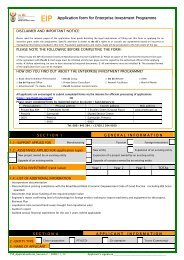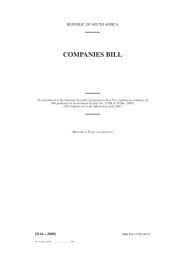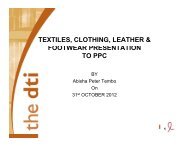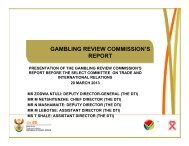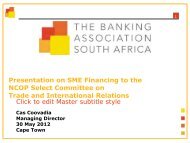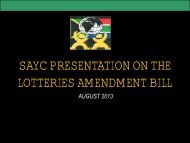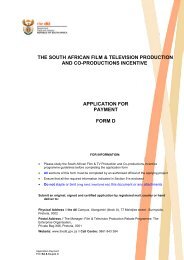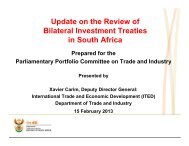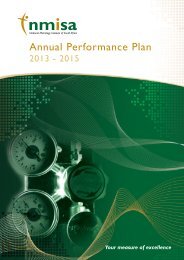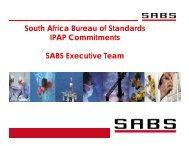Copyright Review Commission Report - ICT Law and Regulation ...
Copyright Review Commission Report - ICT Law and Regulation ...
Copyright Review Commission Report - ICT Law and Regulation ...
- No tags were found...
Create successful ePaper yourself
Turn your PDF publications into a flip-book with our unique Google optimized e-Paper software.
society, the South African Recording Rights Association Ltd (SARRAL), which was accredited to representperformers <strong>and</strong> the owners of copyright in sound recordings <strong>and</strong> which is the fourth respondent in the matter,has since been placed under liquidation. As the proceedings are still pending <strong>and</strong> the issues raised are subjudice, it is not appropriate for the CRC to express its views thereon.3.2.4. SAMPRA was not able to issue licences to other users of sound recordings, namely the broadcasters <strong>and</strong> agroup of retailers who communicate to the public sound recordings owned or exclusively controlled by themembers of RiSA. This was because the broadcasters <strong>and</strong> retailers refused to accept the tariffs proposed bySAMPRA. The disputes between the broadcasters (represented by the National Association of Broadcasters(NAB)), retailers <strong>and</strong> SAMPRA have been referred to the <strong>Copyright</strong> Tribunal for determination <strong>and</strong> are due to beheard in 2012.3.2.5. The NAB contended that the <strong>Copyright</strong> Tribunal could not proceed because the Minister of Trade <strong>and</strong> Industryhad not promulgated regulations governing the conduct of referrals brought under Section 9A of the <strong>Copyright</strong>Act. This contention was rejected by the Tribunal <strong>and</strong>, leave to appeal having been refused, NABunsuccessfully applied for leave to appeal to the Supreme Court of Appeal. Despite SAMPRA's success in thispart of the case, the taking of the point has led to what its chairperson, Mr Keith Lister, described in hisevidence before the <strong>Commission</strong> as a “huge delay <strong>and</strong> cost”.3.2.6. In the referral to the Tribunal, SAMPRA asked not only that the applicable royalty rate be fixed, but also that thebroadcasters be obliged to provide information as to their usage of the sound recordings in respect of which thecopyright was owned or exclusively controlled by SAMPRA. The Act does not impose an obligation in thisregard on users of sound recordings, but Sub-regulations (5) <strong>and</strong> (6) of <strong>Regulation</strong> 7 deal with the matter. Thebroadcasters disputed the validity of the Sub-regulations <strong>and</strong> refused to provide the information sought. MrLister stated that SAMPRA would ask the Tribunal, either before or at the hearing, to order the broadcasters toprovide the information not only prospectively, but also retrospectively.3.2.7. Another issue before the Tribunal in the referral between SAMPRA <strong>and</strong> NAB is the date from which needletimeis payable. Is it: (a) the date when the amending Acts of 2002 came into operation (25 June 2002); (b) the datewhen the regulations came into operation (1 June 2006); or (c) when payment was first dem<strong>and</strong>ed?3.2.8. The broadcasters have declined to pay any amounts into an ‘escrow’ account pending the determination of thedispute regarding the appropriate tariff. The tariff proposed by SAMPRA in respect of the broadcasters wasexplained as follows by Mr Lister in his evidence:[It] is based on a very simple proposition that says if a broadcaster broadcasts no editorial content at all, other thanmusic sound recordings, that the tariff should then be 10% of its income <strong>and</strong> if music sound recordings constitute 70%,then 7% <strong>and</strong> so on.3.2.9. When asked for his estimate of the nature of the loss performers are suffering because of the absence of abinding tariff <strong>and</strong> the failure of the broadcasters to pay royalties for sound recordings used, he said:Our estimate of broadcasters at the moment is that on average the music stations use about 65% of their time tobroadcast music <strong>and</strong> their net revenues are of the order of R3 billion a year. So if you take 6.5% of R3 billion, you get afigure of about R200 million. That would be the top-end per annum from broadcasters, if we were to get the tariff that- 20 -



